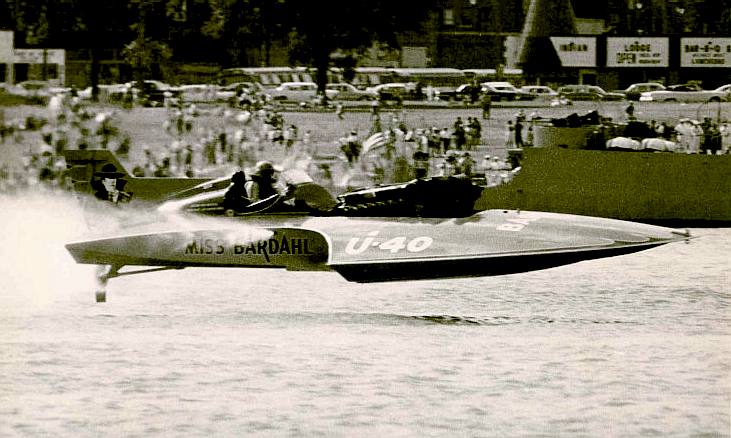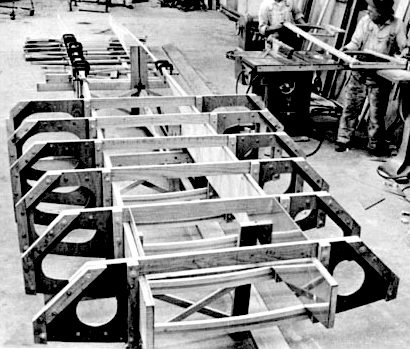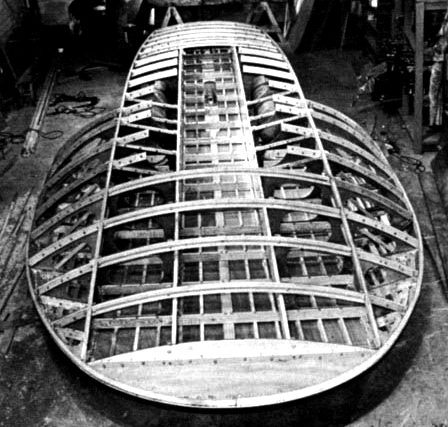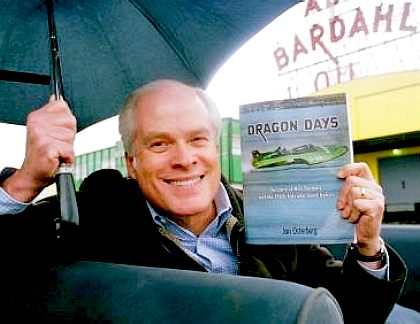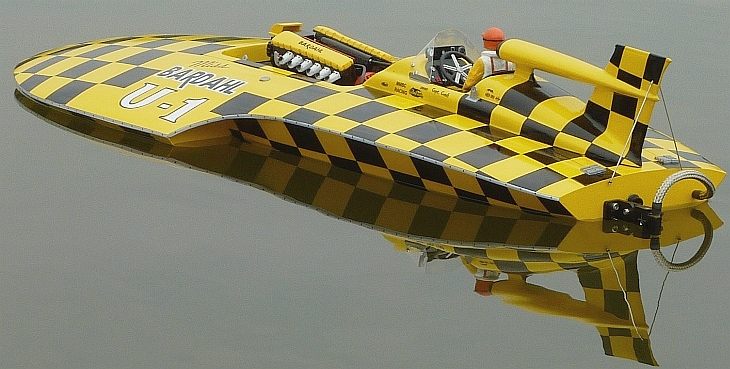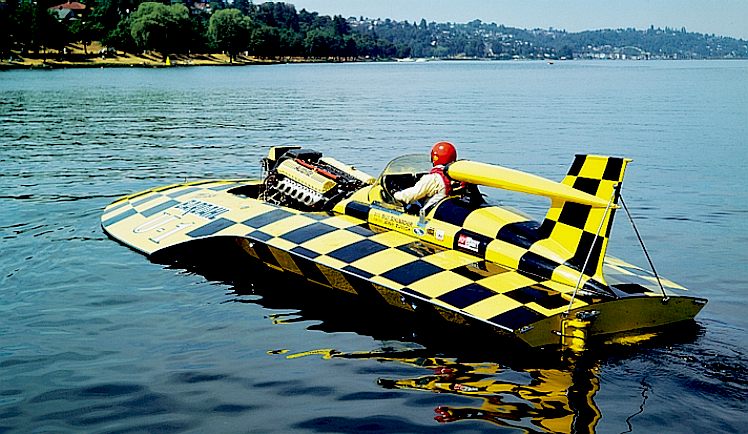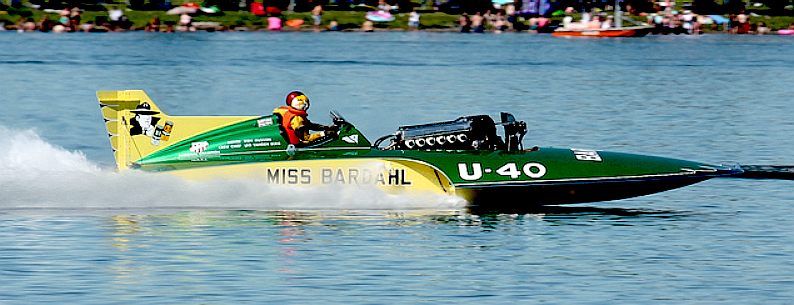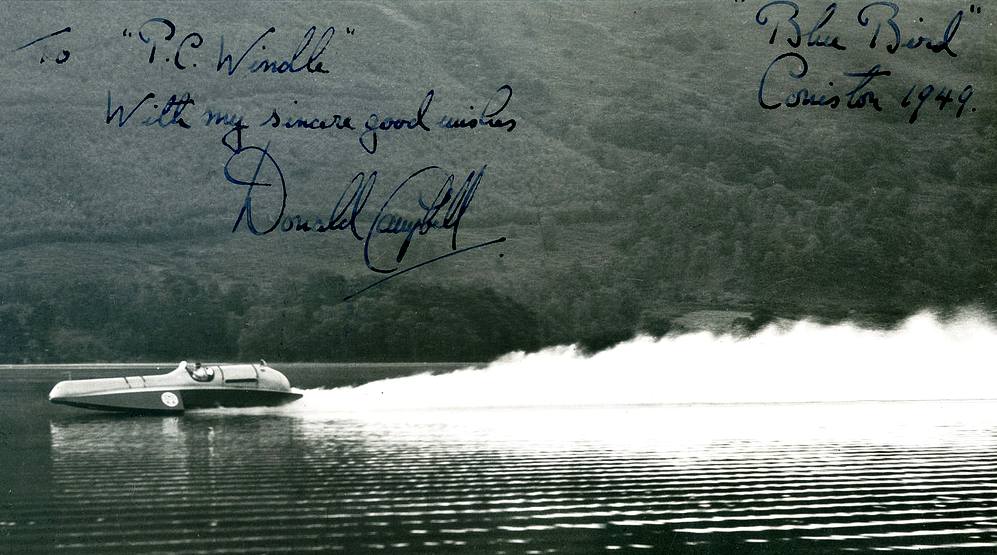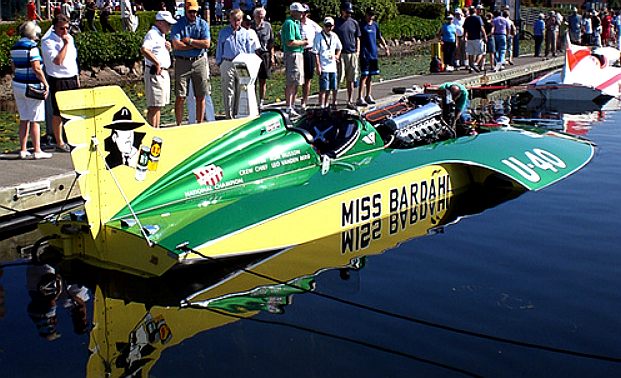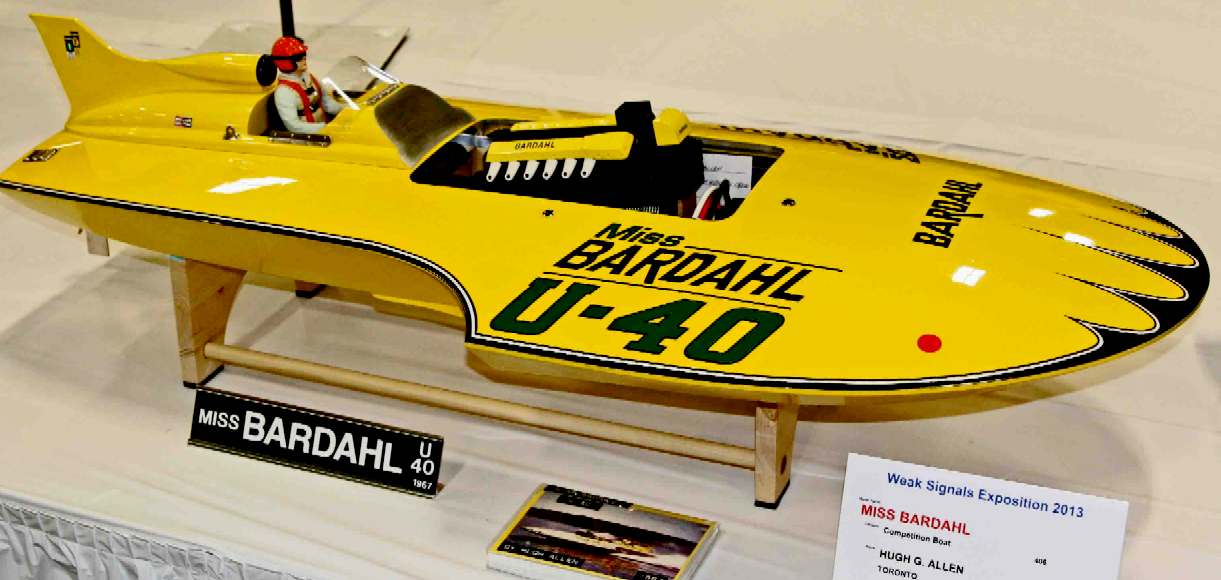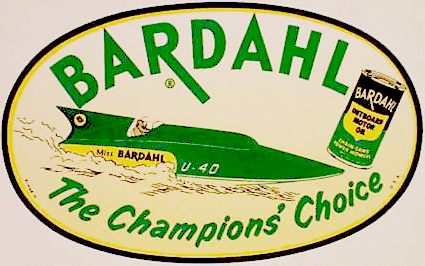|
MISS BARDAHL - RR ENGINED HYDROPLANE
|
|
|
Miss Bardahl is a 30’ long, 7000 lb unlimited hydroplane race boat. Powered by a 3,000 HP Roll-Royce Merlin aircraft engine. This beautifully styled craft is capable of speeds in excess of 180 MPH while literally flying across the surface of the water on a cushion of air. With only three points – 1 propeller blade and the two sponsons – touching the water at any time, Miss Bardahl leaves a “roostertail” of spray over 40 feet high when speeding by. Racing between 1962 and 1965, the team won an unprecedented 3 APBA Gold Cups, 3 National Championships, 1 World Championship, set lap, race and heat records (some which stood almost a decade), and introduced new technology that revolutionized the sport while running a record 57 consecutive heats without an engine failure.
Miss Bardahl was the brainchild of Ole
Bardahl, owner of Bardahl Oil Co. in Ballard. Bardahl, with the help of designer and builder Ted Jones, created a seemingly indestructible speedster that would leave its mark on hydro-history forever.
If only Donald Campbell's K7 Bluebird had been designed with this perfect balance, then there would have been less chance of the flip that proved fatal. To be even more certain of airborne stability, we'd suggest fitting additional air control devices to craft that are expected to exceed 300mph. See Ken Warby's Spirit of Australia.
Where the K3 and K4 Blue Birds had a weight bias to the rear, with the RR Merlin engine as close as practical to the middle of the boat, when it takes to the air, it maintains level flight. The disadvantage is that the prop-shaft is not as horizontal as it could be to give thrust in the opposite direction to the travel of the boat. The angle is though acceptable. A possible cure would be to move the engine slightly forward into the trough of the hull, and use a transfer gearbox below the crankshaft to gain another few degrees closer to the horizontal. This would improve straight line speed. Some adjustment would be needed to fuel tanks to keep the balance that this boat obviously enjoyed. Easy for us to say in hindsight. Or, just fit a jet engine, like the present powerboat racers.
CONSTRUCTION
Miss Bardahl, U-40, was built to order in 1958 for additive oil manufacturer Ole Bardahl by Ted Jones at Bardahl's boat and engine shop. Miss Bardahl is a three-pointer, 30 feet long, 12 feet wide, with a racing trim weight of 6,170 pounds.
This is the build sequence of Miss Bardahl in 1958. It is the same sequence for just about any boat being hand built from wood. Even composite boats need to go through a similar stage to be able to make the moulds, except where foam sheeting is used for one offs.
Miss Bardahl being restored by Michael Hanson. Note that there are many more longerons in the rebuilt hull, as compared to the original build - as seen from the 1958 pictures - roughly three times as many. Better to be safe than sorry. Rebuilds take much more time than working fresh.
RESTORATION
After undergoing a series of unfortunate events that would damage her hull, Miss Bardahl nearly ended her racing career.
Jon Osterberg showing off his book about Miss Bardahl and the hydroplane racing scene in the 1960s.
After three years of searching and one year of bargaining with the owner whose offering price was $20,000, Osterberg convinced the owner to donate Miss Bardahl to Seattle’s Hydroplane Museum for one dollar. Here it was cosmetically rebuilt for show purposes.
This is the U1, Miss Bardahl, radio control scale model boat
This is the U1, three times gold cup winner
BARDAHL ASIA PACIFIC
Bardahl Asia Pacific Pte. Ltd. was set up in Singapore in 2006 as the regional head office to provide comprehensive and timely supports to the Bardahl customers in the region. Besides acting as the logistic hub for the distribution of Bardahl additives made in USA & Europe, Bardahl Asia Pacific produces a wide range of lubricants & additives in Singapore. These include automotive, light & heavy duty vehicles, motorcycles, mining & industrial machinery and marine lubricants & greases. Many of these are specially formulated for the Asia Pacific market requirements.
The block of the RR Merlin engine in situ for alignment purposes, and the cockpit that reveals a steering wheel very similar to that used on the K3 Blue Bird.
THE FIRST RACING HYDROPLANES
Compared
to the K3 and K4 boats of Sir Malcolm Campbell, Miss Bardahl is a very
nice development that shifts weight distribution to an ideal, while also
taking care of some of the transmission complexities, and in so doing
improving performance.
Donald Campbell's Bluebird K4 at speed on Lake Coniston - autographed photograph inscribed: To PC Windle in 1949. Both the K3 and K4 had drives going forward to a transfer box, that then had a prop-shaft going aft. The objective of such transmission was to get the propeller shaft as horizontal as possible to give thrust in the opposite direction to the travel of the boat.
SLO MO SHUN
Early in the morning of 26 June 1950 a small red boat skipped across Lake Washington, near Seattle, and improved on Campbell's record by 29 km/h (18 mph). The boat was called Slo-Mo-Shun IV. It was built by Seattle Chrysler dealer Stanley Sayres. The piston-engined boat was able to run at 160 mph (260 km/h) because its hull was designed to lift the top of the propellers out of water when running at high speed. This phenomenon, called ‘prop riding’, further reduced drag. In 1952 Sayres drove Slo-Mo-Shun to 287.25 km/h (178.49 mph) - a further 29 km/h (18 mph) increase.
The Slo-mo-shun water speed record boat - surface piercing prop rider. This is the boat that inspired so many similar concept wooden hydroplanes.
Miss Budweiser
The renewed American success persuaded Malcolm Campbell's son Donald, who had already driven Bluebird K4 to within sight of his father's record, to make a further push for the record. However, the K4 was by now 12 years old, with a 20 year old engine and Campbell struggled to run at the speeds of the Seattle-built boat. In late 1951 K4 was written-off when it suffered a structural failure at 170 mph (270 km/h) on Coniston Water.
She's a babe - a really beautifully balanced design and not a bad paint job either
Another superb model of Miss Bardahl
LINKS
Vintage Hydroplanes models Jim_Osborne RD_fleet http://www.bluebirdproject.com Ballard News Tribune green-dragon-roars-again http://www.missbardahl.com/restoration/hull_restoration/hull_restoration.htm http://www.missbardahl.com/ http://www.ballardnewstribune.com/2012/11/28/features/green-dragon-roars-again-slideshow http://www.bluebirdproject.com/ https://www.facebook.com/BluebirdSupportersClub http://ginacampbellqso.com/record-attempts/great-britain/ https://www.bonhams.com/auctions/14259/lot/497/ http://www.bluebirdspeedrecords.com/timeline.php http://en.wikipedia.org/wiki/Water_speed_record http://www.touchwoodmodels.com/water-speed-record-models/mach-one-models.html http://www.historicracer.com/motorsport/the-unobtainable-campbell-book-preview/ http://www.sirmalcolmcampbell.com/sirwater.html http://en.wikipedia.org/wiki/Blue_Bird_K4 Orgsites Montgomery Model Boat Club http://www.orgsites.com/al/montgomerymodelboatclub/_pgg9.php3 http://www.bonhams.com/auctions/14259/lot/496/ http://www.bonhams.com/auctions/18213/lot/238/ http://www.bardahl-ap.com/ Arthur Benjamins - http://www.bluebirdpublications.co.uk/
|
|
|
This
website is Copyright © 2017 Bluebird Marine Systems Limited.
The names AmphiMax™,
Bluebird, Bluefish,
SeaVax™,
Solar Navigator™, and the blue bird in flight
|

